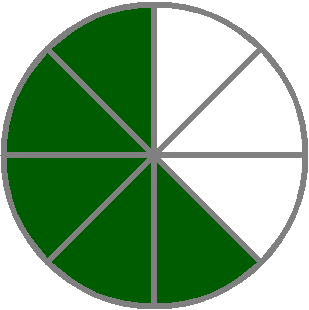So 5 days of fractions under our belt and things are… shaky. As always, some kids seem to viscerally “get it” and others think I am speaking Martian.
Day 1 – naming fractional units, no problem Teach, we learned this in 2nd grade!
Day 2 – partitioning into equal parts, this is easy… wait, odd numbers are hard… wait, there’s more than one possibility?
Day 3 – naming unit fractions… I messed up here. They came away with the understanding of unit fraction = 1 shaded part. This gets confusing when we try to name the unit fraction while looking at visual representations of non-unit fractions. Clarified this the next day – we redefined as one equal part – one of a fractional unit.
Day 4 – Counting unit fractions to name any fractions. I messed up here too. Most kids were so confident in seeing 3 out of 4 equal parts and writing 3/4 that I didn’t spend much time on the counting sequence… 1/4, 2/4, 3/4. 3 copies of 1/4, or 3 of the unit fractions, is 3/4.
Day 5 – It became clear that some kids vaguely understand we have to count something, but what? Shaded parts and unshaded parts?

Most of them can correctly write 5/8. Then you ask about the unshaded part and they might say 3/5, or 5/3, or 8/3. I have tried to redirect with questions: “How many equal parts are in the whole? So what fractional unit is that? So what is each part called? So how could we count the parts?”
We also tried number bonds. Everyone can tell me there are 8 eighths in one whole, or 5 fifths in one whole, etc. but then I throw up the number “1” to stand for one whole and they look at me like I’m insane. I’m getting number bonds like 4/5 and 1/5 make 5. Not sure if they are implying “5 fifths” or are unsure of the concept of “whole.”
Finally, stupid teacher mistake – spring break and end of year testing are looming so I decided to combine two days of objectives from our curriculum. We ventured into the “fractions greater than 1” water. Yikes. With real world and visual representations (oranges, sandwiches), nobody had a problem with the concept of 5/4 or 5/2. But ask them to draw a picture showing 7/4 without context (and maybe those last two words are the problem) and kids’ brains blew up. I got drawings of 4/7, 7 wholes, 7 wholes with 4 wholes shaded, 7 wholes all partitioned into fourths with nothing shaded, and everything in between. No amount of emphasis on “seven FOURTHS” or questions about “So what are fourths? How could you draw that?” or prompts like “Could you start with one whole and go from there?” changed their drawings.
So it seems like several of students are missing a fundamental understanding of “whole” and the understanding of a fraction as “an equal part of a whole.” I’m not sure where to go from here to shore up the gaps.
I think the “whole” idea is fundamental. When given a fairly simple prompt like, “Courtney planted a garden and split it into four equal parts. What fraction of the garden is one part?” about half of my class DOESN’T start by drawing a whole. They draw 4 somethings, or an array with 4 rows and a seemingly randomly number of columns, or a sketch of a garden. Without just drilling them that “the first step is draw the whole,” how do I teach this concept?
I appreciate the depth of thinking here about students’ misconceptions- and I’m wondering if they need something in their hands- have you tried fraction strips/pieces? If they need to really SEE the whole, it seems like it would be helpful to define that for them (for the garden example, a piece of paper is the garden)? Just thinking out loud- but if you think about concrete–> pictorial–> abstract, it seems they need some more time in the concrete in order for things to stick.
LikeLike
We have used fraction strips, fraction circles, and fraction towers… but I think you’re right that we haven’t connected concrete to pictorial enough. And then they struggle even more with the abstract – like that you can draw a rectangle to represent a liter of milk or a bowl of macaroni. A whole is a whole is a whole.
LikeLiked by 1 person
I agree with Courtney. Physical Pattern Blocks (in conjunction with pattern block apps) really help the concept of this piece is 1/3 of a whole, 4 of them is 4/3 & I can arrange them as 3/3 + 1/3 or 1 1/3. Do some rationalizing (pun intended) with redefining what represents a whole. E.g. Initially, 1 whole can be the yellow hexagon. Name all the coloured pieces & show why they are called that. Next time make 3 hexagons make a whole now rename all your pieces. Also I think the use of circles for fractions can be problematic. Rectangles are better and grid paper gives many options for operating with fractions.
Resources:
Click to access PBLCCSS35-0412w.pdf
http://math.rice.edu/~lanius/Patterns/
http://illuminations.nctm.org/Lesson.aspx?id=1315
https://guidedmath.wordpress.com/2010/11/04/math-manipulatives-galore-using-pattern-blocks-in-guided-math-groups/
LikeLiked by 1 person
Thanks for the idea! I think using different pattern blocks as the whole will be really helpful to them. Being able to see each unit fraction as an actual “part” (since each pattern block is a separate entity from its neighbors) will help them see how 4/3 is greater than 1 whole – rather than them just converting 4/3 into 4/6 in their mind – so far they’ve been combining the wholes and changing the unit fraction.
LikeLike